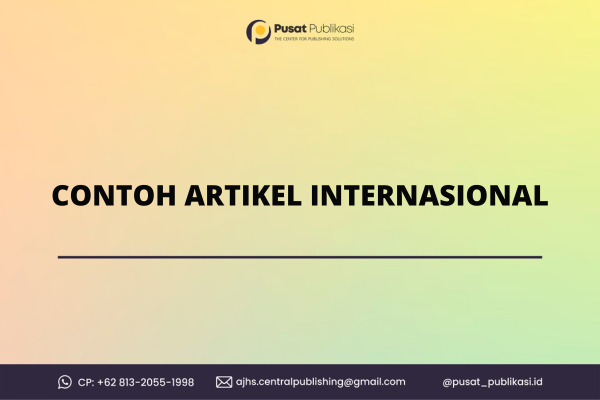Halo sobat Pusat Publikasi, pada pertemuan kali ini kami akan membahas contoh artikel internasional, yuk simak pembahasan di artikel ini sampai habis!
Apa Itu Artikel Internasional?

Apa Itu Artikel Internasional?
Sebelum masuk ke pembahasan utama tentang contoh artikel intermasional, penting untuk memahami terlebih dahulu apa itu jurnal internasional?
Artikel internasional merupakan karya tulis ilmiah yang dipublikasikan di jurnal atau media ilmiah bertaraf global dan diakui oleh komunitas akademik maupun profesional di seluruh dunia.
Biasanya ditulis dalam bahasa internasional, seperti bahasa Inggris, artikel ini membahas topik-topik yang memiliki relevansi serta dampak secara global.
Contoh Artikel Internasional

Contoh Artikel Internasional
The Application of Blockchain Technology in Supply Chain Management
Abstract
Blockchain technology has garnered considerable attention in recent years due to its potential to revolutionize various sectors, particularly supply chain management (SCM). With its decentralized, transparent, and secure method of recording transactions, blockchain helps address several supply chain challenges such as transparency issues, inefficiencies, and fraud. This paper delves into the influence of blockchain on SCM, its potential advantages, and the obstacles faced during its implementation. Additionally, case studies from different industries demonstrate how blockchain has improved supply chain transparency and efficiency.
Keywords: Blockchain, Supply Chain Management, Transparency, Efficiency, Decentralization, Digital Transformation
1. Introduction
Supply chain management (SCM) involves the coordination of processes such as procurement, production, and distribution of goods to ensure efficient delivery from suppliers to customers. However, traditional supply chains often encounter challenges like fraud, inefficient manual processes, and lack of transparency among stakeholders. These issues can lead to delays, higher costs, and a breakdown of trust among participants.
Recently, blockchain technology has emerged as a promising solution for these challenges, especially in SCM. Blockchain operates as a decentralized ledger system, giving all stakeholders access to the same data in real time. This not only enhances transparency but also boosts accountability by preventing any single entity from controlling the entire system.
2. Theoretical Framework
Blockchain, a type of distributed ledger technology (DLT), securely and immutably records transactions. Each transaction is stored in a “block” that is linked to previous blocks, creating a continuous “chain” of data. Compared to traditional centralized databases, blockchain offers several benefits:
- Decentralization: No single party controls the data.
- Transparency: All participants have access to the same data, reducing the chances of fraud.
- Security: Encrypted and immutable transactions make tampering difficult.
In SCM, blockchain enables better product tracking, resource management, and trust among stakeholders.
3. Applications of Blockchain in Supply Chain Management
Blockchain technology can address numerous problems that traditional supply chains face. Key applications include:
3.1 Enhancing Transparency and Traceability
A major advantage of blockchain in supply chains is its ability to track products from their origin to the final consumer. Every step of the product’s journey—production, shipping, and distribution—is recorded on the blockchain. This allows stakeholders to verify product authenticity and condition, increasing trust and minimizing the risk of counterfeiting.
3.2 Improving Efficiency
Blockchain can streamline supply chains by replacing manual, paper-based processes with automated digital workflows. Smart contracts, a feature of blockchain, automatically execute agreements between parties when predefined conditions are met, eliminating the need for intermediaries and speeding up transactions.
4. Challenges in Implementing Blockchain in SCM
While blockchain holds significant potential, its adoption in SCM is not without challenges, such as:
- Scalability: Blockchain networks can become slower and more expensive as they grow.
- Interoperability: Integrating blockchain with existing supply chain systems can be challenging due to differences in technology standards.
- Legal and Regulatory Issues: Conflicting regulations in different jurisdictions can complicate the implementation of blockchain in global supply chains.
5. Case Studies
5.1 Walmart’s Blockchain Implementation for Food Safety
Walmart, one of the world’s largest retail chains, successfully applied blockchain technology to improve food traceability. Partnering with IBM, Walmart developed a blockchain system that tracks food from farm to store. This system has drastically reduced the time needed to trace the source of contaminated food, enhancing both safety and efficiency within the supply chain.
6. Conclusion
Blockchain technology has the capacity to revolutionize supply chain management by enhancing transparency, efficiency, and security. Despite challenges such as scalability and regulatory hurdles, the benefits of blockchain are evident. Companies that implement blockchain in their supply chains will likely experience better product traceability, reduced fraud, and enhanced operational efficiency. As blockchain continues to develop, its use in supply chains will likely grow, contributing to the digital transformation of global industries.
References
- Nakamoto, S. (2008). Bitcoin: A Peer-to-Peer Electronic Cash System.
- Tapscott, D., & Tapscott, A. (2016). Blockchain Revolution: How the Technology Behind Bitcoin is Changing Money, Business, and the World. Penguin.
- Abeyratne, S. A., & Monfared, R. P. (2016). Blockchain Ready Manufacturing Supply Chain Using Distributed Ledger. International Journal of Research in Engineering and Technology, 5(9), 1-10.
Bagi kamu yang ingin mengetahui Scopus Jurnal Internasional, silakan kunjungi blog pusatpublikasi.id atau klik teks biru di paragraf ini ya!
Ciri-ciri Artikel Internasional

Ciri-ciri Artikel Internasional
Ciri-ciri artikel internasional mencakup beberapa aspek penting, antara lain:
1. Berskala Global
Artikel ini dipublikasikan di jurnal yang memiliki jangkauan pembaca internasional dan biasanya diindeks oleh basis data global seperti Scopus, Web of Science, atau PubMed.
2. Berdasarkan Penelitian yang Relevan
Artikel internasional mengandung hasil penelitian atau kajian dengan metode ilmiah yang ketat, dan isinya harus memberikan kontribusi baru dalam bidang tertentu.
3. Menggunakan Bahasa Formal
Bahasa yang digunakan adalah standar akademik internasional, seperti bahasa Inggris, untuk memudahkan komunikasi di antara komunitas global.
4. Peer-reviewed (Ditinjau Rekan Sejawat)
Artikel ini melalui proses peer-review, di mana ahli di bidang yang sama menilai kualitas, validitas, dan kontribusi ilmiah artikel sebelum dipublikasikan.
5. Mengikuti Struktur Ilmiah yang Ketat
Artikel internasional memiliki struktur yang jelas, meliputi abstrak, pendahuluan, metodologi, hasil, pembahasan, kesimpulan, dan daftar pustaka.
6. Berstandar Tinggi
Artikel ini ditulis dengan kaidah yang sangat ketat, baik dari sisi metodologi, tata bahasa, maupun orisinalitas ide yang ditawarkan, sehingga memberikan kontribusi signifikan bagi ilmu pengetahuan.
Akhir kata
Mungkin cukup sekian pembahasan dari kami mengenai contoh artikel internasional, semoga dengan adanya artikel ini bisa bermanfaat. Terimakasih!











Leave a Reply